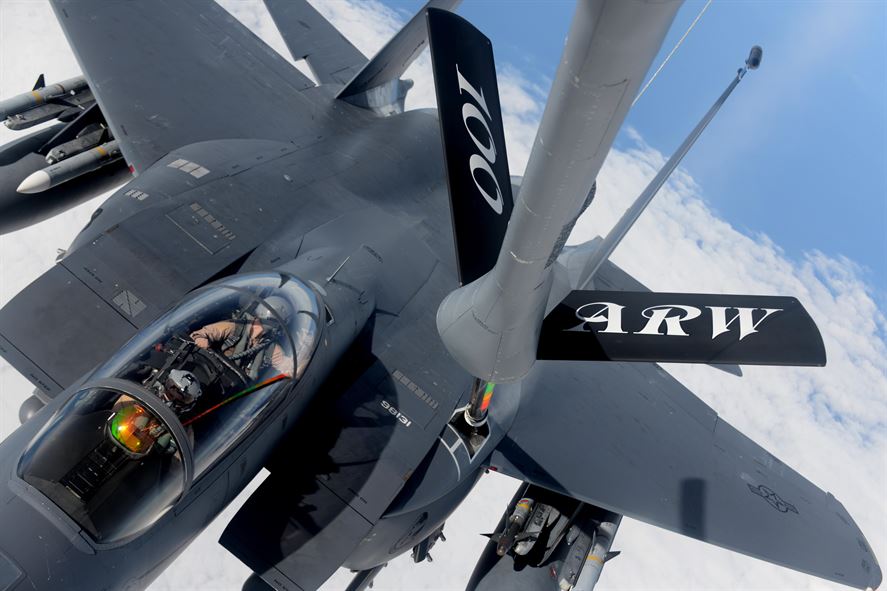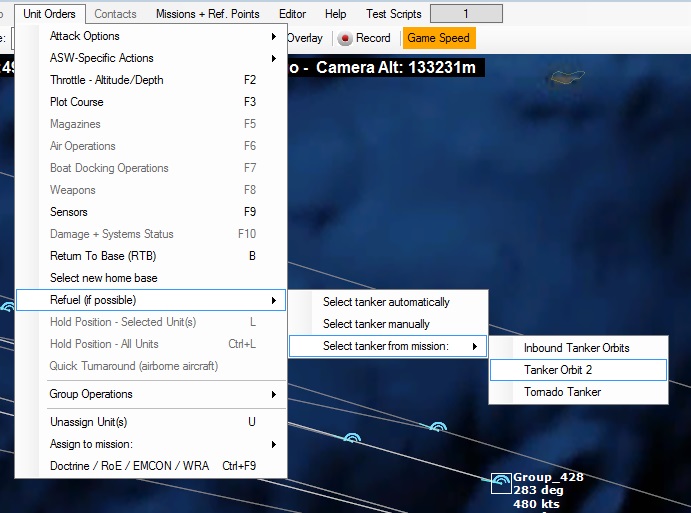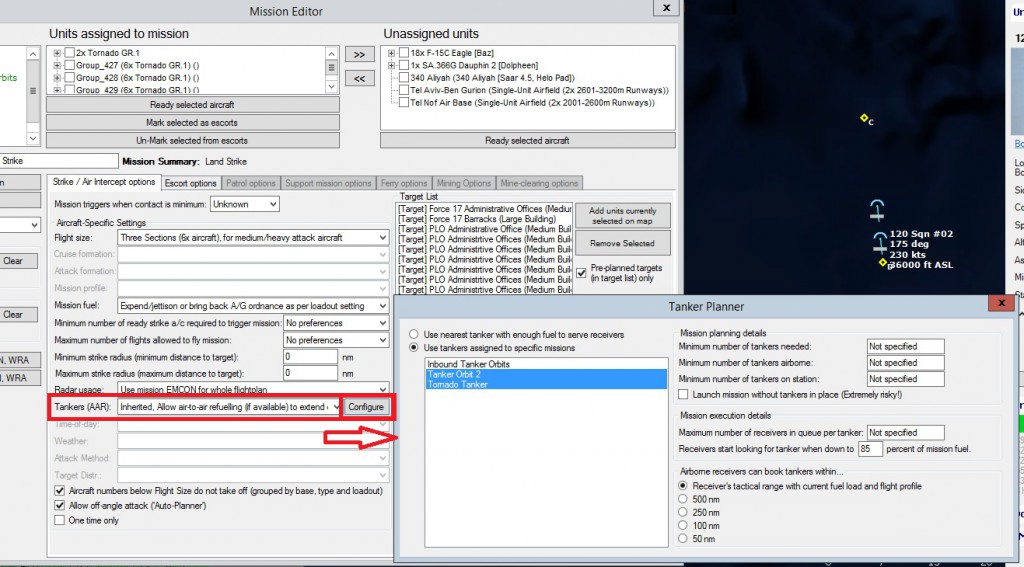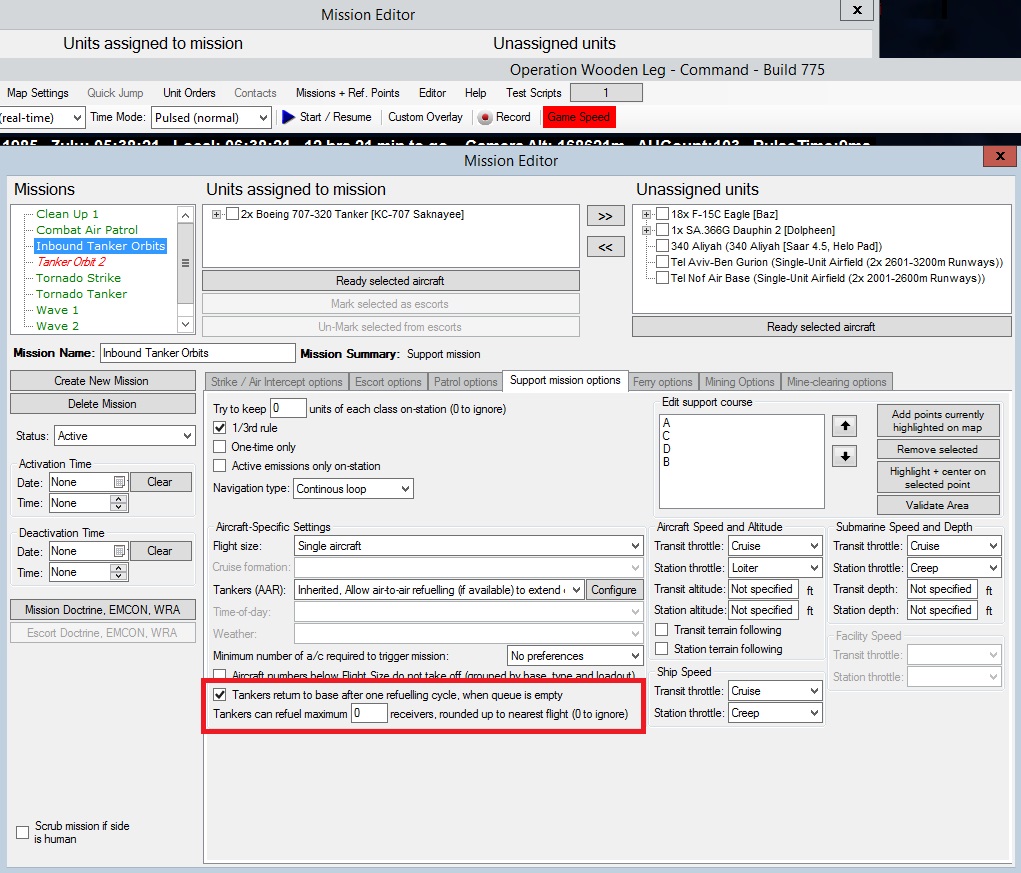The great leaps of v1.11: Massive refuelling improvements
 The v1.10 update for CMANO was released on Feb 26 to widespread acclaim. The dev team is already hard at work preparing the next upcoming major release, version v1.11. After the panoply of new features in past updates, what new tricks do the CMANO devs have up their sleeves? Let’s take a peek.
The v1.10 update for CMANO was released on Feb 26 to widespread acclaim. The dev team is already hard at work preparing the next upcoming major release, version v1.11. After the panoply of new features in past updates, what new tricks do the CMANO devs have up their sleeves? Let’s take a peek.
Massive Air-to-Air Refueling (A2AR) improvements
Air-to-air refueling (A2AR) has been given a complete overhaul. There are significant improvements to the AI’s decision making processes and it is a lot smarter about when and where to refuel. Furthermore, the player is given the ability to manually select which tanker(s) to refuel from, and there are additional options in the Mission Editor to control tanker usage. Tankers will also tell the player which receivers are currently queued for refueling, and display the number of aircraft served thus far. Further super-specialized A2AR improvements are planned for integration into the Advanced Strike Planner, such as ‘refuelling waypoints’, but we believe the current tanker functionality will satisfy 99% of Command players’ needs.
Many players have told us the thing they have missed the most is the ability to manually select which tanker their aircraft should refuel from. You now have three choices:
– Automatic, which is the same behavior as earlier, i.e. the AI picks the most suitable tanker based on remaining fuel and shortest rendezvous time.
– Manual, simply click on the tanker you want to refuel from.
– From mission, pick the most suitable tanker from the tankers assigned to the specified support or ferry mission.
 (Click on image for full view)
(Click on image for full view)
The improved Mission Editor has several new settings for configuring tanker usage. A new window called the ‘Tanker Planner’ allows the player to set the conditions for when tanking should be attempted when the aircraft are in the air, and also set launch conditions for the mission itself. The parameters are as follows:
Use nearest tanker with enough fuel to serve receivers: Airborne receivers assigned to this mission will pick the most suitable tanker based on remaining offloadable fuel and shortest rendezvous time.
Use tankers assigned to specific missions: Limit the tanker pick to those assigned to given missions only. When combined with the new mission Startup and Termination functionality along with the Support Mission ‘One refueling cycle’ and ‘Number of receivers’ limitations (explained below), the player now has the ability to do pretty detailed tanker planning.
Mission planning details – Minimum number of tankers needed: Specify the minimum number of tankers needed to launch this mission. In some cases, especially for larger air strikes, you may need a minimum amount of fuel (2,000,000 lb, hah!) and this setting allows you to postpone strike missions if the tanker requirements cannot be met.
Mission planning details – Minimum number of tankers airborne: Same as above, but specifies the minimum number of tankers that have to be in the air rather than just available.
Mission planning details – Minimum number of tankers on station: This is a further refinement of the above settings and specifies the number of tankers that must be on-station. It only applies to tankers assigned to support missions. Ferry missions are ignored.
Mission planning details – Launch mission without tankers in place (Extremely risky!): The description says it all. In some cases it is desirable to launch a mission without having tankers within tactical radius of the target. Especially in high-threat environments. This setting allows the player to override all built-in safety measures and just launch the strike aircraft regardless of tanker availability at the moment. The aircraft will of course attempt to refuel when airborne, however on the ingress leg they will only attempt to hook up with tankers ahead of them, not behind. Thus it is up to the player or scenario designer to make sure tankers get into position before the receivers run out of fuel and crash. (Dev note: on the return leg, strike aircraft will also look for tankers behind them so the requirements are not so strict there).
Mission execution details – Maximum number of receivers in queue per tanker: In order to prevent one tanker from accepting too many receivers, the player can specify the maximum number of aircraft to send to each tanker.
Mission execution details – Receivers start looking for tankers when down to X percent of mission fuel: By default, strike aircraft will start looking for tankers when down to 85 percent of mission fuel, and aircraft on patrol missions will attempt to refuel when reaching 60 percent. This works well in most cases. However, sometimes it is desirable to delay the search for tankers, and this is a super-nerdy way of doing just that. The setting works for all mission types including Ferry missions. A prettier way to do it is to use the setting below:
Airborne receivers can book tankers within…: When aircraft are down to the fuel percentage specified above, they start looking for tankers. The default is to pick a tanker within the receiver’s tactical range (i.e. strike radius multiplied by two, minus fuel already burned), but the player can also decide that aircraft should only look for tankers within a certain radius.
 (Click on image for full view)
(Click on image for full view)
It is our experience that most players use Support Missions for tanker stations. In order to improve tanker ops flexibility and realism, Command v1.11 adds user-configurable mission termination time (in addition to mission activation time found in earlier versions of the simulator). This allows the player to minimize the tankers’ exposure to threats by de-activating the mission and force them to go home. In addition, the updated Mission Editor adds the ability to make tankers return to base when they have conducted one refueling cycle, or when a specified number of receivers have been served:
Tankers return to base after one refueling cycle, when queue is empty: Tankers will remain on-station for as long as there are receivers in the tanker’s receiver queue. The tankers will accept refueling requests from additional receivers for as long as there is enough fuel, and once all aircraft in the queue have been served the tankers will return to base. This ensures the tankers will only stay on station for as long as they are needed.
Tankers can refuel maximum X receivers, rounded up to nearest flight: Tankers will serve a limited number of receivers. This is especially useful when each tanker carries limited amount of fuel, e.g. when using buddy refueling or when refueling strategic bombers. The number is rounded upwards to the nearest flight. I.e. if the maximum number is six receivers, the tanker will accept two flights of four receivers each. This option can be used in combination with the above setting to create very flexible mission termination conditions.
 (Click on image for full view)
(Click on image for full view)
Comments
Leave a Reply
You must be logged in to post a comment.





